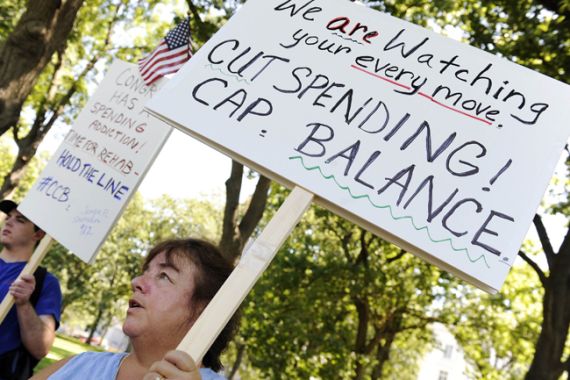Gridlock as US debt limit deadline nears
Republicans and Democrats remain dangerously split over rival plans on debt limit compromise.

US Republicans and Democrats remain in gridlock over raising the country’s debt ceiling while the White House says a compromise is “essential and possible”.
Jay Carney, the White House spokesman, urged legislators to reach an agreement on Wednesday and highlighted partisans’ “need to come together now” to settle on an increased debt limit.
“We believe that there is a place to find compromise,” Carney said.
“And while at midnight on August 2, we don’t all turn into pumpkins, we do as a country lose our borrowing authority for the first time in our history, and that would be a very bad thing.”
“What’s lacking isn’t time … what is required now is political will, and there’s time, if people are willing to find it and use it, there is time to take action,” he said.
He added that the White House has been “intensely engaged in negotiations, in conversations, in proposals and counter-proposals” with Congress at a variety of different levels.
“We still firmly believe that a compromise is essential and possible,” he said.
Dangerously split
The US treasury department says the government will no longer be able to borrow money on August 2, and there is no way to guarantee the government will be able to pay all of its bills without a debt limit increase.
Carney’s comments came as the Democratic-led senate and Republican-led House of Representatives remained dangerously split on Wednesday over rival plans that both tied spending cuts to an increase of the $14.3tn debt limit, but appeared unable to bridge the partisan gap before an August 2 deadline.
John Boehner, the top Republican in Congress who serves as House speaker, is taking a second look at his deficit reduction proposal after seeing some rejection from his party. A non-partisan analysis found it would save less than what he had claimed.
Harry Reid, the senate majority leader, is also tweaking his separate plan after a budget analysis found it would cut $2.2tn from deficits, about $500bn less than claimed.
Separately on Wednesday, Deven Sharma, president of Standard & Poor, told US legislators that he did not believe the US would default on its debt, but warned that the country needs a “credible” plan to slash its deficit to avoid a possible downgrade.
“Changing the rating doesn’t mean that they will default … if you change a rating that means the risk levels have gone up,” he said.
Possible downgrade
Sharma said the credit rating agency’s July 14 threat of a downgrade of the US triple-A rating over its long-term deficit still stands.
“There has to be a credible plan to reduce the debt burden as well as the deficit levels,” he said.
But he said that an earlier $4tn long-term deficit reduction plan, backed by the White House and some in Congress, would probably have been adequate to avoid a downgrade of the country’s vaunted triple-A status.
According to Standard & Poor’s analysis, “that would bring the threshold within the range of what a AAA-rated sovereign debt would require,” Sharma said.
The current plans at the centre of the fight offer cuts of under the $3tn threshold over 10 years.
Pressed on whether there is flexibility to be able to pay the government’s bills after the August 2 deadline, Carney said: “That deadline is hard and fast.”
Carney was also asked whether a downgrade of the US credit rating was a more imminent risk than a default. “A downgrade is a bad thing. A default is a catastrophic thing,” he said.